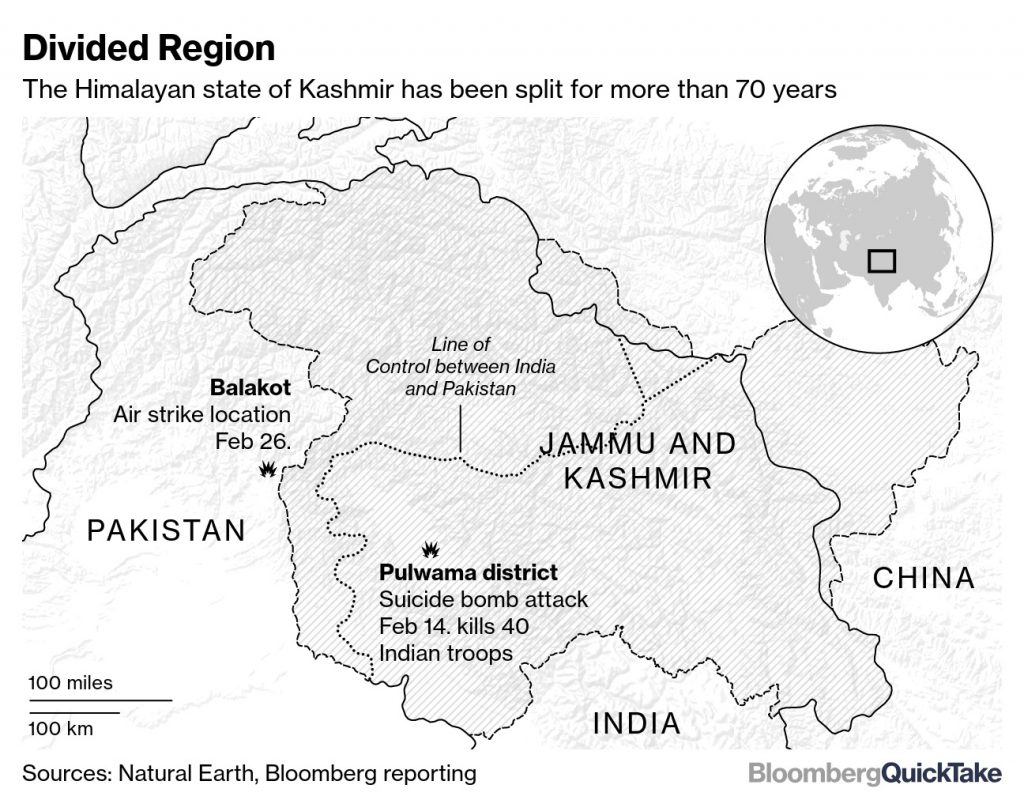Why India and Pakistan Keep Clashing
Two of the world’s most acrimonious neighbors also happen to be among the few countries on the planet to have nuclear weapons. Long-running tension between India and Pakistan centers on the border region of Kashmir, an area in the Himalayas claimed in full — and ruled in part — by both. Violence flares often, as it did early in 2019 when a terrorist attack led to the most serious military escalation in more than a decade. The repeated skirmishing plays out against a backdrop of superpower jockeying by China and the U.S.
1. Why do India and Pakistan distrust each other?
The independent nations of India and Pakistan were created by the partition of British India in 1947, which was largely driven by religion: Pakistan became primarily Muslim while India remained mostly Hindu. The drawing of new borders uprooted 14 million people and resulted in sectarian violence that killed as many as 1 million people. The two countries have fought three major wars since then, two of them over Kashmir. Pakistan’s leaders have seen India as an existential threat since the partition, which some believe India still hopes to reverse. India has been frustrated by what it sees as the Pakistan military’s support for terrorists that strike inside its territory.
2. What’s so special about Kashmir?
At the time of partition, India and Pakistan courted the subcontinent’s various kingdoms (which were only indirectly ruled by the British) to join their fledgling nations. The Hindu ruler of Muslim-majority Kashmir — a region roughly the size of the U.K., with 12.5 million people today — dithered over which to join. Pakistani politicians sponsored an invasion by irregular fighters, India intervened and the two countries fought to a stalemate. Today they face off along a 460-mile (740-kilometer) de-facto border known as the Line of Control, one of the most heavily militarized zones in the world.

3. How often do they fight?
Artillery and small-weapons fire are exchanged often, but clashes rarely escalate to the level seen in February, after a suicide bomber killed 40 Indian paramilitary police in the part of Kashmir controlled by India. Jaish-e-Mohammed (Soldiers of Mohammed), a Pakistan-based jihadist group, claimed responsibility. India responded with its first airstrikes on Pakistani soil since 1971, which led to an aerial dogfight. Tension eased when Pakistan returned a captured Indian pilot. It was the closest India and Pakistan came to another war since an attack on Parliament in New Delhi in 2001 that was blamed on that same group and another, Lashkar-e-Taiba (Army of the Pure).
4. Does Pakistan harbor terrorists?
Yes, according to its neighbors, the U.S. and many other countries. U.S. President Donald Trump in 2018 withheld $2 billion of security aid to Pakistan, saying it provided safe haven to the “terrorists we hunt in Afghanistan,” including Taliban insurgents. The leaders of Lashkar-e-Taiba, responsible for deadly attacks across Mumbai in 2008, also live in Pakistan, as did al-Qaeda head Osama bin Laden. The multinational Financial Action Task Force has Pakistan on a grey list of countries with inadequate controls over money laundering and terrorism financing. Pakistan Prime Minister Imran Khan has vowed to curb militant groups, some of which, such as the Haqqani network, grew out of the U.S.-backed fight against the Soviets in Afghanistan in the 1980s. But Pakistan’s civilian leaders have had little power to shape foreign or security policy, an area dominated by the military and the main spy agency, Inter-Services Intelligence. The generals have been accused of supporting such groups as proxies to indirectly harry Indian forces and to prevent Afghanistan from falling under Indian influence, which provokes fears of encirclement.
5. How are China and the U.S. involved?
India has moved closer to the U.S. as it keeps a nervous eye on China’s growing influence across Asia. Pakistan is among the biggest beneficiaries of China’s Belt and Road Initiative, attracting some $60 billion of investments including in the part of Kashmir administered by Pakistan, much to India’s consternation. While Pakistan still serves as a key supply route for American forces operating in neighboring Afghanistan, U.S. influence in Pakistan has waned. Trump can’t afford to alienate Pakistan entirely, however, as he wants to withdraw U.S. forces from the Afghan conflict and Pakistan has played a key role in bringing the Taliban insurgents to the negotiating table.
6. Will India and Pakistan ever settle their differences?
Khan, who took office in 2018, has called for renewed dialogue with New Delhi. His Indian counterpart Narendra Modi used the February clash to whip up support during his reelection campaign. Previous peace talks have failed. The U.S., China and other world powers urge restraint when crises flare. Pakistan and India remain wary of a full-blown conflict, each deterred by the other’s nuclear arsenal. Meanwhile, the people living in the Kashmir region have endured decades of human-rights violations and abuses at the hands of security forces on both sides, according to a 2018 report by the UN High Commissioner for Human Rights.
The Reference Shelf:
The economic pressures behind February’s India-Pakistan clash, and a graphic-laden look at how Modi has or hasn’t changed India.
The first-ever UN human rights report on Kashmir.
Bloomberg Opinion’s Pankaj Mishra examines India’s armchair generals, Mihir Sharma asks whether India is becoming more like Pakistan, and Hal Brands looks at Trump’s cuts to aid for Pakistan.
A Lowy Institute report on the resurgence of Jaish-e-Mohammed.
The New Yorker on the violent legacy of Indian partition and a teaching guide from the U.K. National Archives.
“Midnight’s Furies: The Deadly Legacy of India’s Partition.” A book by Bloomberg Opinion’s Nisid Hajari. 